Museum of the Origins of Man
PALEOLITHIC THREE-DIMENSIONAL ART
THE HUMAN HEAD IN PALEOLITHIC SCULPTURE
The typology of the human head is divided into 5 phases:
- from 2,500,000 to 750,000 years (Oldowan);
- from 750,000 to 400,000 years (Acheulean and ancient Clactonian);
- from 400,000 to 200,000 years (Acheulean and middle Clactonian);
- from 200,000 to 40,000 years (Acheulean and recent Clactonian, and Mousterian);
- from 40,000 to 12,000 years (Upper Paleolithic).
Note on dating: the Oldowan in East Africa begins 2,500,000 years ago (absolute dating), while in Southern Europe it began about 1,000,000 years ago. Considering that African and European artifacts are practically the same, and with very little evolution over 1,500,000 years, we consider "conventionally" the parity of Africa and Europe; and we indicate the end of the Oldowan with the appearance of the Clactonian, dated to 736,000 years at Isernia La Pineta (Italy).
This typology is constituted in Oldowan by the representation of the human head without neck (Fig. 4,1). The depiction of the head with body (Fig. 4.18) comes later.
In the upper Paleolithic also sculptures of female human heads appear. The human figure is present in Africa in the upper Paleolithic also in painting, along with zoomorphic figures, but it is not sure if it derives from this typology.
The representation of the human head, if not having a strong stylistic deformation, represents the man which has produced it, and allows to establish also the human species; as for example to distinguish Homo sapiens Neanderthalensis from Homo sapiens sapiens.


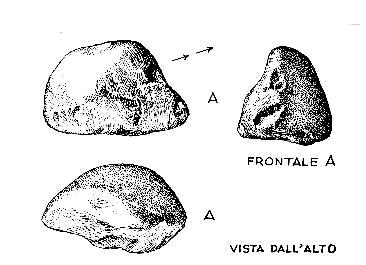
Fig. 4.1) Stone sculpture. Obtained from a pebble of flint.
It represents the head of a hominid, probably Homo habilis.
Size: Height: cm 4,5.
Origin: S.Severo, Foggia, Italia.
Material culture: Oldowan (Pebble Culture)
The head is depicted without jaw, or maybe the jaw is just outlined; it was found in secondary deposit along with lithic tools, and it is slightly damaged by alluvial tumbling.
Collection Museum of the Origins of Man.

Fig. 4.2) It represent the head of a hominid.It is obtained from a nodule of flint.
Size: Height cm 6.
Origin: Rodi Garganico, Foggia, Italy.
Material culture: Oldowan (Pebble Culture evolued).
The working concerns the face, the skullcap, and the back of the neck. The depicted hominid species seems to be close to Australopithecus robustus, and in any case to other hominids, preceding Homo erectus. The sculpture presents tumbling traces, but it is not disfigured.
Collection Museum of the Origins of Man.

Fig. 4.3) Stone sculpture. Obtained from a green stone pebble.
It represents the head of a Homo erectus, type with prominent jaw.
Size: Height cm 9.
Origin: Vesima, Genoa, Italy.
Material culture: Acheulean or ancient Clactonian
There are no findings of skulls of Homo erectus with prominent jaw, but only sculptures (see Fig. 4,4 - 4,5 - 4,6 - 4,7). The type of stone, not too hard, has allowed an accurate working of the details of the face.
Collection Museum of the Origins of Man.

Fig. 4.4) Stone sculpture. Obtained from a white stone pebble. It represents the head of Homo erectus type with prominent jaw.
Size: Height cm 9.
Origin: Tortona, Alessandria, Italia.
Material Culture: Acheulean or ancient Clactonian.
This sculpture is worked from every side, and is in relief, while behind is flat. If seen frontally, the face is depicted in the half, that is, there is only one eye. It is slightly damaged by alluvial tumbling.
Collection Museum of the Origins of Man.

Fig.4.5) Stone sculpture. Obtained from a pebble of green stone. It represents the head of a Homo erectus with prominent jaw.
Size: Height cm 7.
Origin: Vicenza, Italy.
Material culture: Acheulean or ancient Clactonian, or, perhaps, middle.
This sculpture is almost semifrontal, in how much the chin is frontal, while the face and the head are only half-worked, because behind is flat. The working under the nose seems to indicate the mouth. Under the jaw there is a hollow, purposely wanted. It has a stylistic deformation to the horizontal elongation. There is absence of forehead, but the face preludes Pre-sapiens. It is slightly disfigured by alluvial tumbling.
Collection Museum of the Origins of Man.
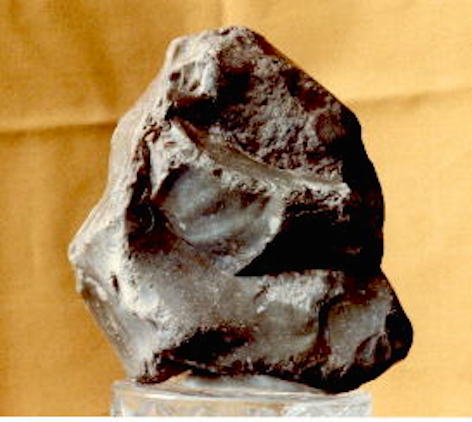
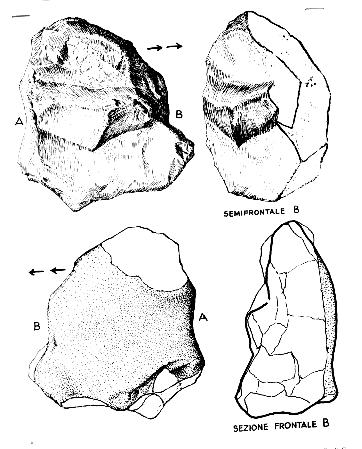
Fig. 4.6) Stone sculpture. Obtained from a nodule of flint. It represents a head of Homo erectus with prominent jaw.
Size: Height cm 11.5.
Origin: Rodi Garganico, Foggia, Italy.
Material culture: Acheulean or ancient Clactonian.
The workmanship is rough, due also to the hardness of the stone, but essential, since the whole lateral profile of the head of Homo erectus with prominent jaw is well represented; and the cheekbone is also of considerable importance, as of great dimensions, even if artistically disproportionate.
The alluvial tumbling did not damage the shape.
Collection Museum of the Origins of Man.
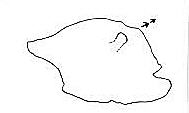

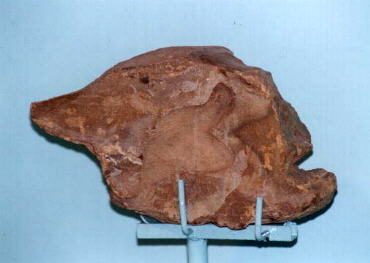
Fig. 4.7) Stone sculpture. Obtained from a great nodule of flint. It represents a head of Homo erectus with prominent jaw.
Size: Lenght cm. 46.
Origin: Mouthiers, Charente, France.
Material culture: Acheulean or middle Clactonian.
The eye and the mouth are are constituted by two natural hollows of the flint nodule, and this stone was probably chosen
specifically. The chin is carved as if the depiction were frontal; it is sketched out from the two sides with large removals. The pointed neck is made from the original shape of the flint nodule, perhaps, was chosen for this reason, and may have a meaning that is unknown to us: a ritual headgear? The wide open mouth in the typology is interpreted as a "scream".
Collection Museum of the Origins of Man.
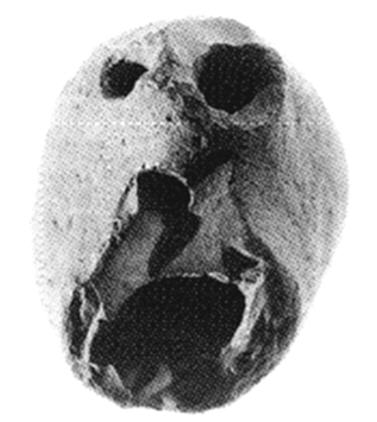
Fig. 4.8) Stone sculpture. It represents the head of a hominid.
Size: probably it is high approximately 15 cm., and this is deduced from the worked sides.
Origin: probably Valley of the Somme.
Material culture: Acheulean or middle Clactonian, or perhaps final.
This sculpture has been found by JACQUES BOUCHER DE PERTHES presumibly in the first half of the nineteenth century.
Technique of working: obtained from a flint nodule empty inside, the worked parts that can be seen in the photograp are the enlargement of the larger eye; the enlargement of the mouth, where the removals are very clear at the sides and below, in correspondence of the chin area. The wide open mouth is so large, that in our typology is interpreted as a "scream", which is also a representation of "movement", just as is "movement" a bull jumping in Magdalenian painting.
Current location: probably Musée des Antiquités Nationales de Saint-Germain-en-Laye (Paris).

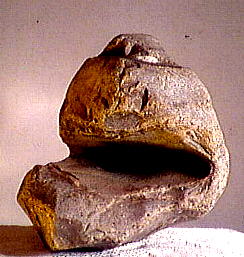
Fig. 4.9) Stone sculpture. Obtained from a large nodule of silex. It represents the head of a hominid with great opened wide mouth.
Size: height cm 23,5, length cm 29, width cm 18,5. The mouth is wide cm 17 inside and cm 7 in the tip of the jaw, and is deep cm 11. Weight kg. 11.5.
Origin: Romandato Torrent, Rodi Garganico, Foggia, Italia.
Material culture: Acheulean or middle Clactonian, or perhaps recent.
The sculpture has been obtained from a large nodule of silex, in which the cavity that constitutes the open mouth is part of the original shape of the nodule.
The strong expression has been interpreted in the typology as a "scream". The stylistic deformation is based on the scream.
A study about this sculpture and about other two similar ones, (Fig. 4.7 and 4.10) entitled "The scream of Homo erectus" is published on "Paleolithic Art Magazine", by Pietro Gaietto(2000).
Collection Museum of the Origins of Man.

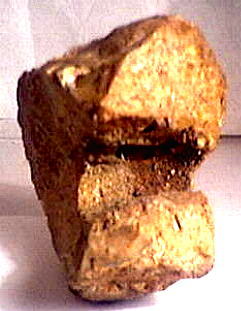
Fig. 4.10) Stone sculpture. Obtained from a nodule of silex. It represents the head of a hominid with opened wide mouth.
Size: Height cm 8.5, lenght cm 9, width cm 5.5. Weight kg. 0.340.
Origin: Spinacchi, Vico Garganico, Foggia, Italy.
Material culture: Acheulean or middle Clactonian, or, perhaps, recent.
The sculpture has been obtained from a nodule of flint, in which the cavity that constitutes the open mouth is part of the original shape of the nodule. It has been worked on the two sides with sharp removals. The tip of the jaw is worked in accurate way, as well as the other sculptures of the same type that represent the scream.
Collection Museum of the Origins of Man.
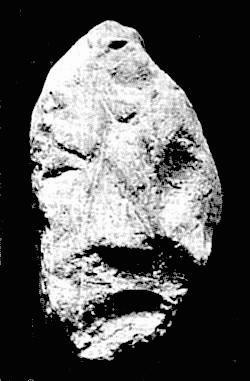 Fig. 4.11) Stone sculpture. It represents a human head in frontal view.
Fig. 4.11) Stone sculpture. It represents a human head in frontal view.
Size: Height cm. 21.
Origin: Wittenbergen, Northern Germany.Found by Prof. WALTER MATTHES.
Material culture: Acheulean or recent Clactonian, perhaps Mousterian.
It is a rare type in frontal view. It has a closed eye and an open one. Of this type of representation there are two findings of the second millennium A D. (Fig.4A14 and 4A15).
Unknown location; could be held by W. Matthes' son.
 Fig. 4.12) Stone sculpture. It represents a head of acromegalic type.
Fig. 4.12) Stone sculpture. It represents a head of acromegalic type.
Size: Height cm 7.5.
Origin: Sulldorf, Northern Germany.Found by Prof. WALTER MATTHES.
Material culture: Mousterian (opinion of W.Matthes), but perhaps upper Paleolithc. See other acromegalic types: Fig.3.20 - 4.21 - 5.39 - 5.40.
Unknown location; could be held by W. Matthes' son.
 Fig. 4.13) Stone sculpture. It represents a head of Homo sapiens neanderthalensis.
Fig. 4.13) Stone sculpture. It represents a head of Homo sapiens neanderthalensis.
Origin: Voltri, Genova, Italia.
Material culture: Mousterian.
The sculpture is in relief from the part that is seen in photograph, behind is flat. It has been rolled, but is not disfigured. The high part of the skullcap is probably a headgear, also because is thinner toward the top.
Collection Museum of the Origins of Man.

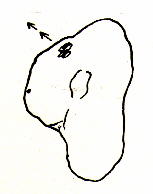 Fig. 4.14) Stone sculpture. It represents a head of Homo sapiens neanderthalensis with neck, and look upwards.It is worked from both sides, about in the round. It has a pointed neck. It is a classic Neanderthalian.
Fig. 4.14) Stone sculpture. It represents a head of Homo sapiens neanderthalensis with neck, and look upwards.It is worked from both sides, about in the round. It has a pointed neck. It is a classic Neanderthalian.
Size: Height cm 15.
Origin: Valle del Vero, Toirano, Savona, Italy.
Material culture: Mousterian.
Collection Museum of the Origins of Man.
 Fig. 4.15) Stone sculpture. It represents a head of Homo sapiens neanderthalensis, probably a woman, it has the neck, and a pointed hood or a pointed hairdo, and look upwards.
Fig. 4.15) Stone sculpture. It represents a head of Homo sapiens neanderthalensis, probably a woman, it has the neck, and a pointed hood or a pointed hairdo, and look upwards.
Size: Height cm 14.
Origin: Grotta delle Capre, Monte Circeo, Latina, Italy.
Material culture: Mousterian, perhaps posterior.
The face is proportioned in size and thickness. The hood and neck are thinned. Behind it is flat.
Collection Museum of the Origins of Man.
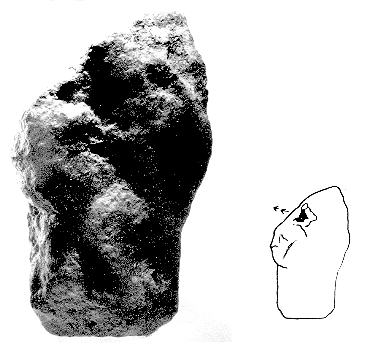 Fig. 4.16) Stone Sculpture. It represents a head of Homo sapiens neanderthalensis, probably a woman; the neck is nearly a bust; it has a pointed hood or a pointed hairdo, and look upwards.
Fig. 4.16) Stone Sculpture. It represents a head of Homo sapiens neanderthalensis, probably a woman; the neck is nearly a bust; it has a pointed hood or a pointed hairdo, and look upwards.
Size: Height cm 10.
Origin: S.Pietro d' Olba, Savona, Italy.
Material culture: Mousterian.
The setting of the sculpture is almost semifrontal, but behind it is flat. It has pointed lips, like in other two heads of Neanderthalians (Fig. 4.17 and 5.20), that just for the lips can be hypothesized as representations of women.
The sculptures of pointed heads represent almost all Neanderthalians, but is not known if they are male or female, and are attributed to the Mousterian, and perhaps to the first millennia of the upper Paleolithic. The hypothesis that these pointed heads are female is based on the female statuettes (Venuses), that have the same type of head, and the same hairstyle or hood.
Collection Museum of the Origins of Man.
 Fig. 4.17) Stone sculpture. It represents a head of Homo sapiens sapiens neanderthalensis, interpreted as a young woman.
Fig. 4.17) Stone sculpture. It represents a head of Homo sapiens sapiens neanderthalensis, interpreted as a young woman.
Height: cm 57. It is the largest paleolithic woman's head known.
Origin: Pianpaludo, S.Pietro d'Olba, Savona, Italy.
Material culture: Mousterian.
The face is well shaped, and has a stylistic deformation, which makes the young woman's eye particularly elegant. The neck is robust, and even paleoanthropologist sustain that Homo sapiens Neanderthalensis was stronger and more robust than Homo sapiens sapiens sapiens.
This sculpture, which has a high and beautiful relief, behind is flat like others, and it is possible that its placement on the ground was horizontal, but it is also probable that the neck was used to fix it in the ground to give it a vertical position.
Collection Museum of the Origins of Man.
 Fig. 4.18) Stone sculpture. Human figure with look up.
Fig. 4.18) Stone sculpture. Human figure with look up.
Size: Height: cm 20. The sculpture is thick cm 5, and behind is flat.
Origin: Palo, S. Pietro d' Olba, Savona, Italy.
Material culture: Mousterian, perhaps beginning of the upper Paleolithc.
It depicts a Neanderthal, even for its thick and short neck. It has the chin, thus could be a recent Neanderthalian. The body is represented, except the legs. The whole arm is shown in relief.
Collection Museum of the Origins of Man.
 Fig. 4.19) Stone sculpture. It represents a head of Homo sapiens neanderthalensis without neck.
Fig. 4.19) Stone sculpture. It represents a head of Homo sapiens neanderthalensis without neck.
Size: Height cm 7.2.
Carved on a pebble of red silex.
Origin: Senigallia, Ancona, Italy.
Material culture: Mousterian, but perhaps previous.
The setting of the head is semifrontal.
Collection Museum of the Origins of Man.
 Fig. 4.20) Stone sculpture. It represents a head of Homo sapiens Neanderthalensis.
Fig. 4.20) Stone sculpture. It represents a head of Homo sapiens Neanderthalensis.
Size: Height cm 11 approximately. The sculpture has been found and drawn in 1931 by PHILIPPE HÉLÉNA who had attributed its manufacture to Neanderthal Man.
Origin: Great Cave of Bize, Narbonne, France.
Material culture: Mousterian.
The sculpture has a semifrontal setting, and has been drawn in semifrontal and lateral view.
Unknown location, perhaps at the Archaeological Museum of Narbona.
 Fig. 4.21) Stone sculpture. It represents a human head with chin and without forehead.
Fig. 4.21) Stone sculpture. It represents a human head with chin and without forehead.
Size: Height cm 18.
The sculpture, well shaped, is carved from a large fragment of rock, and on one side only. It could also be an incomplete sculpture, from which one had to get a second head, to make it a bicephalic sculpture.
Origin: S.Pietro d' Olba, Savona, Italy.
Material culture: Mousterian or upper Paleolithc.
Collection Museum of the Origins of Man.
 Fig. 4.22) Stone sculpture. It represents a human head without the neck.
Fig. 4.22) Stone sculpture. It represents a human head without the neck.
Strong stylistic deformation in ironic sense, deduced from the large nose.
Size: Height cm 12.
Origin: Tortona, Alessandria, Italy.
Material culture: Mousterian, but perhaps previous.
It comes from an ancient flood of the Scrivia torrent, and is damaged, as there are no more traces of external workmanship, but are present in the hollows that constitute the orbital area and the mouth.
The human type seems an archaic Homo sapiens, but has no chin, and little forehead. The style elongates the head vertically.
Collection Museum of the Origins of Man.
 Fig. 4.23) Stone sculpture.It represents a human head without neck, and with a pointed hood.
Fig. 4.23) Stone sculpture.It represents a human head without neck, and with a pointed hood.
Size: Height cm 16.
Origin: Tiglieto, Genoa, Italy.
Material culture: perhaps upper Paleolithc.
The human type depicted looks like an archaic Homo sapiens sapiens, but we should not forget that the varieties of Homo sapiens sapiens must have been many, as today there are many more. An equal type is found in the anthropomorphic menhir of Carnac (Fig. 4,24), with which it has in common the big nose, the hood or the hair, if it is a woman; the chin, and the style in vertical elongated sense, even if proportioned to the real.
Collection Museum of the Origins of Man.
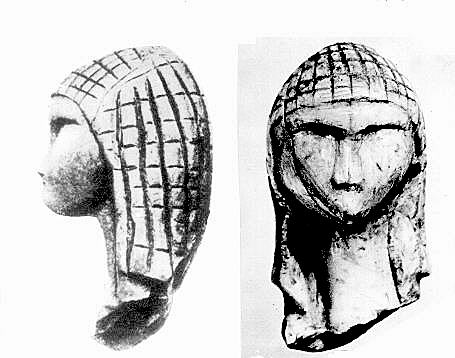 Fig. 4.24) Ivory sculpture. Female head with "nubian" hairstyle.
Size: Height cm 4; the face is high cm 1.5 approximately.
Origin: Brassempouy, France.
Material Culture: Aurignacian-Perigordian.
Fig. 4.24) Ivory sculpture. Female head with "nubian" hairstyle.
Size: Height cm 4; the face is high cm 1.5 approximately.
Origin: Brassempouy, France.
Material Culture: Aurignacian-Perigordian.
The execution of the face is influenced by the Mousterian tradition, as the lateral profile is better executed than the frontal one, which is devoid of mouth. It has the same type of "nubian" hairstyle of the Neanderthalian woman (Fig. 5,32) represented in the bicephalic sculpture of the Balzi Rossi, along with a Homo sapiens sapiens.
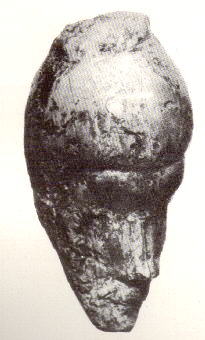 Fig. 4.25) Mammoth ivory sculpture. Female head with hairbinding.
Fig. 4.25) Mammoth ivory sculpture. Female head with hairbinding.
Height: cm 4.8.
Origin: Dolni Vestonice, Moravia, Czechoslovakia.
Material culture: Gravettian.
The representation is elegant, and the stylistic deformation enlarges the neck and tightens the face from the top to the chin. It has no ears or neck, and looks looking downward. The hair, which enlarges the neck, seems to be tied at the top. A similar hairstyle is found in the bicephalic sculpture of Toirano Cave (Fig. 5,30), in which also the human type is similar.
 Fig. 4.26) Fig. 4.26) Stone sculpture. It represents a human head with neck and hat or hairdo.
Fig. 4.26) Fig. 4.26) Stone sculpture. It represents a human head with neck and hat or hairdo.
Size: Height cm 46. The work is in the photographed part, behind it is flat.
Origin: Vara, S.Pietro d'Olba, Savona, Italy.
Material culture: upper Paleolithc, and perhaps Mousterian.
The represented human type could be a woman, both because it is beardless, and because the hair goes down from the neck, and is put in relief in the sculpture, as seen in the drawing. However, the men of the Mousterian or of the upper Paleolithic, considering that the greater part of the carved heads are beardless, could very well shave their beards, as they still do today in many areas of the East, plucking their hair one after another, deliberately ignoring razors.
The re-entering face of this sculpture has a confirmation in an anthropomorphic menhir of Carnac (Fig. 4,28).
Collection Museum of the Origins of Man.
 Fig. 4.27) Stone sculpture. It represents a human head in frontal view. Behind it is flat.
Fig. 4.27) Stone sculpture. It represents a human head in frontal view. Behind it is flat.
Size: Height cm 33.
Origin: Andora, Savona, Italy.
Material culture: Mousterian or upper Paleolithc.
Found in the bed of a creek, it has signs of rolling, which however are not disfiguring. This type of frontal representation is rare, and the stylistic deformation tends towards the essential, and not to the imitation of the head.
Collection Museum of the Origins of Man.

 Fig. 4.28) Stone sculpture. It represents a head of Homo sapiens sapiens, with beard and hairs, without neck and behind flat.
Fig. 4.28) Stone sculpture. It represents a head of Homo sapiens sapiens, with beard and hairs, without neck and behind flat.
Size: Height cm 24.
Origin: Palo, S. Pietro d' Olba, Savona, Italy.
Material culture: upper Paleolithc.
Collection Museum of the Origins of Man.
 Fig. 4.29) Stone sculpture. It represents a head of Homo sapiens sapiens with neck.
Fig. 4.29) Stone sculpture. It represents a head of Homo sapiens sapiens with neck.
Size: Height cm 27.
Origin: S.Pietro d'Olba, Savona, Italy.
Material culture: upper Paleolithc.
It is worked from both sides, and is nearly a frontal representation. This type of sculpture, with high and robust neck, is present in various anthropomorphic menhirs at Carnac, with different types of Homo sapiens sapiens.
Collection Museum of the Origins of Man.
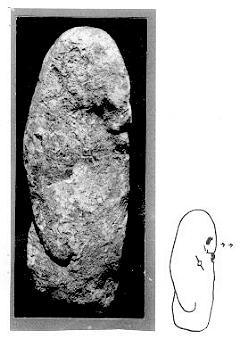 Fig. 4.30) Stone sculpture. It represents a bearded head with body.
Fig. 4.30) Stone sculpture. It represents a bearded head with body.
Size: Height cm 7.5.
Origin: Tiglieto, Genoa, Italy.
Material culture: upper Paleolithc
Eye, nose and moustache are clearly depicted; for the beard there are slight incisions. At the height of the mouth is engraved a rhombus with two lines. An arm is depicted, but not the legs. Behind it is flat.
Collection Museum of the Origins of Man.
NEXT
Index
HOME PAGE
Copyright©1999-2020 by Museum of Origins of Man, all rights reserved.







































